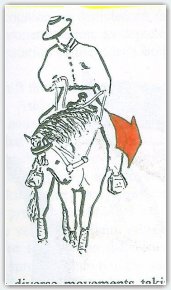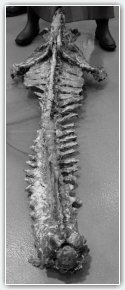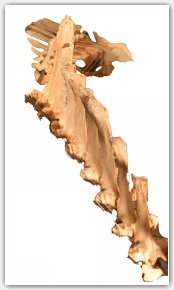Part VII
Response to the waspish ghosts of theological thinking.
Part VII
“Everything should be made as simple as possible but not simpler.” (Albert Einstein)
Equestrian theories are for a great part simpler, the safety rein, half halt, stretching of the neck, side reins, legs without hands and hands without legs, etc. etc. These theories came with the label scientifically proved, which means that partial scientific findings have been distorted to accredit the theory. In a recent talk, epidemiologist Ben Goldacre denounced as bad science, the misrepresentations or convenient omissions that food industries and others, including the equestrian industry, are using to sell their products.
When in the history of riding a theologian came up with the theory, legs without hands and hands without legs, the thought was based on simplistic thinking and complete ignorance of the fact than any complex living organism, such as the horse, is composed of systems within a system within a system. The Dopeys of the equestrian world emphasized the superficial results. They totally ignored the chain reaction from which superficial to microscopic level is going to efficiently orchestrate the horse’s physique, thereby leaving potentially crippling effects.
A rein action that may appear efficient at one level may induce adverse and damaging effects at a deeper level. The so-called safety rein for instance, promises control by bending the horse’s neck intensively.  Promoters never talk about both the physical and mental damages that the rein action is causing. Whether their omission is directed by plain or convenient ignorance, the damages are abnormally stressing the horse’s physique.
Promoters never talk about both the physical and mental damages that the rein action is causing. Whether their omission is directed by plain or convenient ignorance, the damages are abnormally stressing the horse’s physique.
In this rubric, we refer to theologians of the equestrian world as Ghosts, because they live in an unreal world. The prefix waspish refers to the ghosts’ nastiness. Their equestrian theories are off of reality but their egos do not allow them to look for more intelligent and efficient approaches. Their energy is then concentrated on proving that they are right and criticizing anyone who does not venerate them. Look very much like fanatic religions does it not?
Since, like humans, horses suffer from bad science and benefit from real science, we are going to expose through this rubric and in the light of most recent scientific discoveries, the side and hidden effects of simpler theories starting with the safety rein as well as every lateral bending of the neck achieved through reins effects.
“In the cervical and thoracic vertebral column, rotation is always coupled with lateroflexion and vice versa.” (Jean Marie Denoix, 1999). In the horse’s thoracolumbar column, transversal rotations occur mostly in the vicinity of the 9th to 14th thoracic vertebrae but do have an effect on the whole thoracolumbar spine. Transversal rotations can be proper, enhancing the horse’s performances, or inverted, hampering the horse’s ability to move and perform efficiently.
Bending the neck by pulling on the inside rein does induce inverted rotation. Beside shifting the weight on the outside shoulder and therefore altering proper kinematics of the outside foreleg, the inverted rotation induces abnormal stresses on the vertebral structures. A horse, like a human, is inherently asymmetrical. Rotations are therefore always preferential one direction over the other. If not addressed by the training approach, and if aggravated by the riding technique, the imbalance between right and left rotation evolves rapidly into handicapping dysfunction.
This specimen is the thoracolumbar column of a 10 year old horse.  Even if relatively young, the horse’s thoracolumbar spine is severely crooked. With all the muscles removed, the thoracolumbar spine lays twisted on the table. The thoracolumbar spine is laterally bent to the left and the lateral bending is coupled with an inverted rotation. For reference, the color picture shows the proper correlation between left lateral bending and correct rotation.
Even if relatively young, the horse’s thoracolumbar spine is severely crooked. With all the muscles removed, the thoracolumbar spine lays twisted on the table. The thoracolumbar spine is laterally bent to the left and the lateral bending is coupled with an inverted rotation. For reference, the color picture shows the proper correlation between left lateral bending and correct rotation. 
The specimen was clearly crooked and it was impossible to illicit any right lateral bending. However, before becoming a specimen, this thoracolumbar column belonged to a live horse. Perhaps it would be enlightening to envision how a horse with such crookedness would be able to deal with the rein action illustrated earlier. As a horse can easily bend the neck without bending the thoracolumbar spine, the horse would probably comply to the rein action bending the neck to the right. However, incapable of bending the thoracic spine into the same direction, the horse would do what every horse is doing. He would execute the performance protecting his muscular imbalance.
In this specific case, left lateral bending is associated with inverted rotation shifting the dorsal spines to the right. In the scientific world such rotation is referred to as left rotation because the ventral part of the vertebral bodies is facing left. Right lateral bending of the thoracic spine is difficult to execute with such inclinations of the dorsal spines. The only way the horse could do it would be stiffening the whole thoracic spine and rushing forward, leaning heavily on the right shoulder. Maybe the horse attempted such a solution and was punished for his behavior.
Perhaps, the horse was capable of correcting somewhat the transversal rotation, placing his dorsal spines into a more vertical position. According to the difficulty that the horse would encounter doing such adjustment, the correction would either allow a light right lateral bending of the thoracic vertebrae or, to the contrary, an intense protective reflex contraction of the surrounding muscles stiffening the thoracic spine. Very likely, the horse’s disobedience would be treated by further bending the neck inducing greater pain.
One can easily predict that the so-called safety rein applied on this horse would likely stimulate a violent protective reflex contraction, thereby questioning the concept of safeness associated with the intense lateral bending of the neck. Believers will argue that the specimen presented here is a rare exception. Unfortunately it is not. Three specimens were presented one week later in the same necropsy room. They all presented the same level of thoracolumbar torsion, two specimens were twisted to the right and one was cocked to the left. In fact, when a horse is said to travel with the haunches to the left, or canter with the haunches to the inside, or is dropping the right shoulder, or does not like the right lead canter, or many other issues, the horse’s thoracolumbar spine likely is twisted as much or even more than the specimen presented in this discussion.
The horse’s vertebral column is often described as the axis of motion. The limbs are situated on each side of the spine and the thrust generated by the hind legs is transmitted forward through the column. Both hind and front legs induce oblique forces on the thoracolumbar spine which tends to bend the column laterally. The front legs bend the thoracic spine and the hind legs induce lateral bending in the lumbar spine. The lumbar vertebrae have very little capacity of lateral bending, so the hind legs' actions influence lateral bending of the thoracic vertebrae. Basically, alternative lateral bending of the thoracolumbar column are synchronized with the hind and front limbs action. However, without proportional resistance of the back muscles, the hind and front limbs would induce sideway motion of the spine and very little forward movement. The main function of the back muscles is therefore not to increase lateral and transversal movements of the thoracolumbar column but instead reduce these movements through supple resistance. As the speed increases, the resistance of the back muscles further stiffens the vertebral column. Hence, any asymmetry between left and right lateral bending and rotation alters the kinematics of the hind and front legs. The irrational and in fact damaging effect of simpler riding techniques creates inverted rotation and therefore aggravates natural back muscles’ imbalance.
A German proverb says, “Even the lion has to defend himself against flies.” Any crookedness of the thoracolumbar spine renders forward movement uncomfortable for the horse. Even the more willing athlete has to protect himself from physical discomfort. Difficulties to perform, frustration, anger, protective reflex contraction, result from uneasiness. Instead of being interpreted as behavior issues, these reactions need to be treated as outcome of a dysfunctional physique trying to cope with physical distress.
Bending the neck of a young horse is a disastrous lesson. The spine is the axis of motion. Inducing greater lateral bending of the cervical vertebrae, (the neck,) than the thoracic vertebrae, breaks the vertebral column alignment shifting the weight to the outside shoulder. It does not take long for a horse to learn the lesson. If the horse is confused or uncomfortable with forward motion, he will apply the lesson by over bending the neck and shifting his body sideways.
The ones who promote lateral bending of the neck have not thought their theories through beyond the superficial level. The horse does not work at the superficial level. All living creatures are composed of tiers of systems within a system within a system. Most of the systems are not directly controlled by the rider, but the cascade of reactions can be directed either toward proper efficient physical coordination or physical dysfunction.
Simple is knowledge and clarity in the understanding of complex mechanisms. Simpler is dumb
Jean Luc Cornille Copyright©2011
(The next installment will be about Half Halt.)
Sign up for our free newsletter Drowning the fish.





 twitter
twitter facebook
facebook delicious
delicious digg
digg google
google stumbleupon
stumbleupon newsvine
newsvine reddit
reddit linkedin
linkedin blogger
blogger